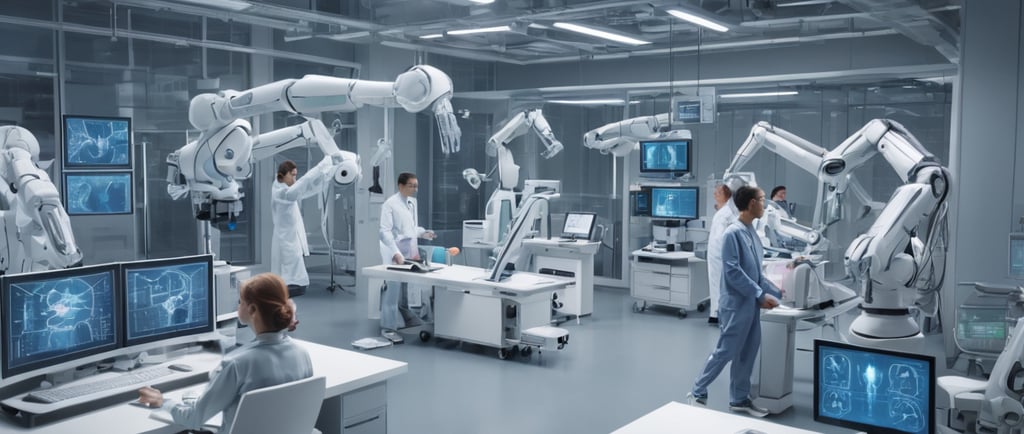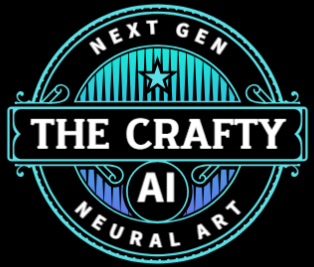Will AI Replace Your Job? What You Need To Know
Explore AI's impact on healthcare, finance, and manufacturing with case studies. Learn which jobs, like medical coders and truck drivers, face automation risks in 5-10 years, plus emerging roles, ethics, and strategies to thrive.
AI TAKEOVER


Artificial Intelligence (AI) is reshaping the global workforce, driving unprecedented changes across industries like healthcare, finance, and manufacturing. By automating routine tasks, enhancing decision-making, and enabling new capabilities, AI is revolutionizing how work is done. This blog explores AI-driven innovations through case studies, predicts how AI will shape the job market over the next decade, and identifies which jobs are most at risk of automation, as well as how AI will adapt to new roles replacing human labor.
AI in Healthcare: Revolutionizing Care Delivery
In healthcare, AI is transforming diagnostics, treatment planning, and patient care. Machine learning models analyze medical imaging, such as X-rays and MRIs, to detect conditions like cancer with accuracy rivaling or surpassing human experts. For example, Google Health’s DeepMind developed an AI system that identifies breast cancer in mammograms with a 5-10% higher accuracy rate than radiologists, reducing false positives and speeding up diagnoses.
AI also powers personalized medicine. IBM Watson Health analyzes patient records and genomic data to recommend tailored treatment plans for cancer patients, improving outcomes. Virtual health assistants, like those from Babylon Health, use natural language processing (NLP) to provide 24/7 patient support, triaging symptoms and scheduling appointments, which reduces the burden on healthcare professionals.
Case Study: PathAI
PathAI uses AI to assist pathologists in diagnosing diseases from tissue samples. Its algorithms analyze slides to detect abnormalities, reducing diagnostic errors by up to 20%. This has streamlined workflows in hospitals, allowing pathologists to focus on complex cases while AI handles routine analyses.
Future Impact: AI will likely automate repetitive tasks like medical transcription, billing, and preliminary diagnostics. Jobs such as medical coders and transcriptionists face high automation risk within 5-10 years, with studies estimating 80% of these roles could be replaced. However, new roles like AI system trainers and medical data annotators will emerge, requiring skills in data science and healthcare knowledge.
AI in Finance: Enhancing Efficiency and Security
The finance sector is leveraging AI to streamline operations, enhance customer experiences, and combat fraud. AI-powered robo-advisors, such as Betterment and Wealthfront, use algorithms to manage investment portfolios, offering low-cost, personalized financial advice. These platforms analyze market trends and client risk profiles to optimize returns, disrupting traditional financial advisory roles.
Fraud detection is another key application. JPMorgan Chase’s COiN platform uses AI to analyze legal documents and detect fraudulent transactions, processing thousands of contracts in hours—a task that once took human analysts weeks. Similarly, AI systems monitor real-time transaction data to flag suspicious activities, reducing financial losses by up to 30% in some cases.
Case Study: Ant Financial’s MYbank
MYbank, part of Alibaba’s ecosystem, uses AI to assess creditworthiness for small businesses in rural China. Its algorithms analyze transaction data, social media activity, and other non-traditional metrics to approve loans in seconds, serving over 20 million businesses. This has democratized access to finance, replacing manual loan processing roles.
Future Impact: Routine financial jobs like loan officers, bank tellers, and data entry clerks are highly automatable, with 60-70% of these roles at risk by 2030, according to McKinsey. New jobs will emerge in AI model development, cybersecurity, and regulatory compliance, requiring expertise in machine learning and data privacy.
AI in Manufacturing: Driving Automation and Precision
Manufacturing is undergoing a transformation with AI-powered automation. Smart factories use AI to optimize production lines, predict equipment failures, and reduce downtime. For instance, Siemens employs AI-driven predictive maintenance systems that analyze sensor data to forecast machine breakdowns, cutting maintenance costs by 20-30%.
Robotics powered by AI, such as those from FANUC, perform complex tasks like welding and assembly with precision, reducing human error. Collaborative robots (cobots) work alongside humans, enhancing productivity while maintaining safety through AI-driven motion detection.
Case Study: Tesla’s Gigafactory
Tesla’s Gigafactory uses AI to optimize its battery production line. Machine vision systems inspect components for defects, while AI algorithms adjust production parameters in real-time to maximize efficiency. This has increased output by 15% and reduced labor costs, though it has decreased demand for manual assembly workers.
Future Impact: Jobs like assembly line workers, quality inspectors, and warehouse operators face a 70-90% automation risk in the next decade, per Oxford Economics. Emerging roles include robotics technicians, AI system integrators, and supply chain analysts, demanding skills in robotics programming and data analytics.
Jobs at Risk of Automation
AI’s ability to automate repetitive, rule-based tasks puts several job categories at risk over the next 5-10 years. According to studies by Frey and Osborne (2017) and the World Economic Forum, the following roles are most vulnerable:
Administrative Roles: Data entry clerks, receptionists, and clerical workers face automation through AI tools like robotic process automation (RPA), which can handle repetitive tasks like scheduling and invoicing.
Transportation and Logistics: Truck drivers and delivery workers are at risk as autonomous vehicles, like those from Waymo, advance. By 2030, up to 50% of driving-related jobs could be automated.
Customer Service: Call center agents and retail cashiers are being replaced by AI chatbots and self-checkout systems, with 60% of these roles potentially obsolete.
Routine Manual Jobs: Factory workers and warehouse pickers face displacement due to AI-driven robotics and automation systems.
Estimates suggest 20-30% of current jobs could be automated by 2030, with low-skill, repetitive roles most affected. However, AI’s impact varies by region and industry, with advanced economies facing higher automation rates due to greater technology adoption.
The Future Job Market: AI-Driven Opportunities
While AI will displace certain jobs, it will also create new ones, particularly in roles that require creativity, emotional intelligence, and technical expertise. AI is unlikely to fully replace jobs requiring complex decision-making or human interaction, such as teachers, therapists, or strategic managers. Instead, it will augment these roles, enhancing productivity.
Emerging Jobs:
AI Trainers and Ethicists: Professionals will be needed to train AI models and ensure they adhere to ethical standards, addressing issues like bias and fairness.
Data Scientists and Analysts: As AI relies on data, demand for data scientists to interpret and manage datasets will grow, with a projected 36% job growth by 2030 (U.S. Bureau of Labor Statistics).
Human-AI Interaction Designers: These professionals will design intuitive interfaces for AI systems, ensuring seamless collaboration between humans and machines.
Sustainability Analysts: AI will support green initiatives, creating roles to analyze environmental data and optimize resource use.
Case Study: AI in Education
Platforms like Duolingo use AI to personalize learning, adapting lessons to individual progress. This has created demand for AI curriculum developers who design adaptive educational content, a role that didn’t exist a decade ago.
How AI Will Adapt to New Jobs Replacing Humans
As AI automates routine tasks, it will evolve to support hybrid work models where humans and machines collaborate. For example, AI will augment roles like doctors by providing diagnostic support, allowing them to focus on patient care. In creative industries, AI tools like DALL-E generate initial designs, but human creativity refines them, creating a symbiotic relationship.
Over the next 5-10 years, AI will adapt by:
Enhancing Collaboration: AI will integrate into workflows via tools like co-pilots (e.g., GitHub Copilot for coding), assisting rather than replacing workers.
Upskilling the Workforce: AI-driven learning platforms will offer personalized training, helping workers transition to new roles. For instance, Coursera uses AI to recommend courses based on career goals.
Creating Hyper-Specialized Roles: AI will enable niche jobs, such as AI bias auditors or robotic process optimization specialists, requiring specialized training.
To prepare, workers must focus on upskilling in areas like data literacy, critical thinking, and AI system management. Governments and companies will need to invest in reskilling programs to address workforce displacement, with initiatives like Amazon’s Upskilling 2025 program training 100,000 employees in AI-related skills.
Ethical and Societal Implications
AI’s transformation of work raises ethical concerns. Automation could widen income inequality, as low-skill workers face job losses while high-skill roles grow. Bias in AI systems, such as in hiring algorithms, must be addressed to ensure fairness. For example, Amazon’s scrapped AI recruitment tool favored male candidates due to biased training data, highlighting the need for ethical AI development.
Governments will play a crucial role in mitigating these challenges through policies like universal basic income or retraining subsidies. Transparent AI governance and regular audits will ensure systems remain fair and inclusive.
Predictions for the Next Decade
By 2035, AI will likely:
Automate 20-30% of current jobs, with repetitive roles most affected.
Create millions of new jobs in AI development, data science, and human-AI collaboration.
Shift education toward STEM and soft skills like adaptability and problem-solving.
Drive hybrid work models, where AI augments human tasks across industries.
Require global workforce reskilling to address automation-driven displacement.
Industries like healthcare, finance, and manufacturing will continue to lead AI adoption, with applications like AI-driven drug discovery, algorithmic trading, and smart factories becoming standard. The job market will reward adaptability, with workers who embrace lifelong learning thriving in an AI-driven world.
Conclusion
AI is not just transforming industries—it’s redefining the future of work. Through innovations in healthcare, finance, manufacturing, and beyond, AI is enhancing efficiency, enabling new capabilities, and creating opportunities for growth. While routine jobs face automation risks, new roles will emerge, demanding skills in data, ethics, and human-AI collaboration. By embracing upskilling and ethical AI development, society can navigate this transformation to create a future where technology and human ingenuity work hand in hand. The next decade promises a dynamic, AI-driven job market, and those who adapt will shape its evolution.
You may also like to read this article: The Future of AI: What to Expect in the Next 5-10 Years.

